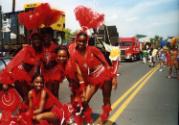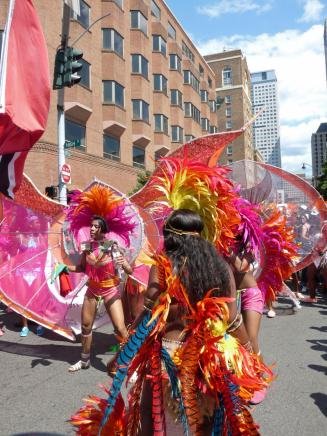West Indian Independence Day Parade, 2002
Date2002 July 27
Mediumprint photographs
ClassificationsGraphics
Credit LineConnecticut Cultural Heritage Arts Program collections
CopyrightIn Copyright
Object number2015.196.541.1-.4
DescriptionPhotographs of the West Indian Independence Day Parade on July 27, 2002.
(.1) Image of masqueraders posing for a group portrait at the West Indian Independence Day Parade on North Main Street in Hartford.
(.2) Image of masqueraders marching in the West Indian Independence Day Parade on North Main Street in Hartford.
(.3) Image of a group marching in the West Indian Independence Day Parade on North Main Street in Hartford.
(.4) Image of a masquerader in the King costume marching in the West Indian Independence Day Parade on North Main Street in Hartford.
NotesSubject Note: A significant wave of West Indian immigration to the United States began in the 1940s. Many settled in the Hartford area because the labor shortage of World War II meant there were available jobs in the tobacco fields along the Connecticut River Valley. Men worked in the fields while women often found work as housekeepers, teachers, nurses, and aides. Local organizations helped transition new immigrants to Connecticut culture and offered friendship, housing, economic opportunities, and community connections. Today, Connecticut’s West Indian community includes immigrants from all the islands in the Caribbean. They have established significant sports, cultural, and social clubs, dance and music groups, and produce an annual week-long festival that attracts audiences from all over the Northeast. With Greater Hartford now being home to the third largest West Indian community in the nation, beloved traditions like Carnival have been transplanted and sustained here.(.1) Image of masqueraders posing for a group portrait at the West Indian Independence Day Parade on North Main Street in Hartford.
(.2) Image of masqueraders marching in the West Indian Independence Day Parade on North Main Street in Hartford.
(.3) Image of a group marching in the West Indian Independence Day Parade on North Main Street in Hartford.
(.4) Image of a masquerader in the King costume marching in the West Indian Independence Day Parade on North Main Street in Hartford.
In 1962, Jamaica and Trinidad and Tobago claimed their Independence from Great Britain. Since that year, the West Indian Parade and Independence Celebration has been a highlight of Hartford’s summer activities. The week of activities includes many events taking place at the different island clubs around Hartford and features headlining musicians who perform at the West Indian Social Club. The celebration concludes with a parade and festival in Hartford featuring floats, steel band performances, and masqueraders displaying brilliant costumes.
The Hartford celebration is based on Carnival, a pre-Lenten celebration of spring and renewal in the islands, especially Trinidad. Masquerading, or playing Mas is an essential part of Carnival. Mas represents a theatrical adoption and presentation of roles and characters that originally expressed mockery of upper classes. Colorful, often spectacular costumes designed by traditional Mas artists depict fanciful themes or current issues. Gossamer fabrics, plumes and feathers, sequins and gems used in previous years are recycled to express the new year’s themes. During Carnival parades, groups of masqueraders form bands and dance to calypso or soca music. As West Indians have spread out from the islands, Carnival has been transplanted to cities around the world during different times of the year. Mas and Carnival serve as central expressions of Caribbean cultural identity and heritage.
Additional audio, video, and/or photographic materials exist in the archive relating to this community and these events.
Cataloging Note: This project was made possible in part by the Institute of Museum and Library Services MA-245929-OMS-20.
Status
Not on view2011 August 13













